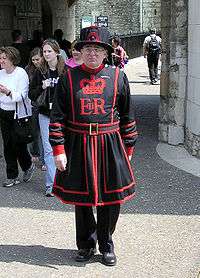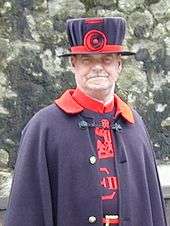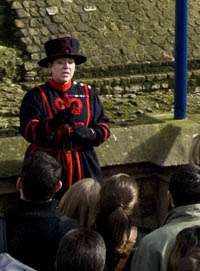Yeomen Warders
The Yeomen Warders of Her Majesty's Royal Palace and Fortress the Tower of London, and Members of the Sovereign's Body Guard of the Yeoman Guard Extraordinary, popularly known as the Beefeaters, are ceremonial guardians of the Tower of London. In principle they are responsible for looking after any prisoners in the Tower and safeguarding the British crown jewels. They have also conducted guided tours of the Tower since the Victorian era.
| Yeomen Warders of Her Majesty's Royal Palace and Fortress The Tower of London | |
|---|---|
 Badge of the Yeomen Warders | |
| Active | 1485 (1509: see History) – present |
| Country | United Kingdom |
| Role | Palace and Fortress Guard |
| Garrison/HQ | London |
| Motto(s) | Dieu et mon droit |
| Commanders | |
| Colonel in Chief | HM The Queen |
| Insignia | |
| Collar Badge | Rose, Thistle and Shamrock |
%2C_full_restoration.jpg)
All warders are retired from the Armed Forces of Commonwealth realms and must be former warrant officers with at least 22 years of service. They must also hold the Long Service and Good Conduct medal. Since 2011, the garrison has included 37 Yeomen Warders and one Chief Warder.[1][2]
The Yeomen Warders are often incorrectly referred to as Yeomen of the Guard, which is actually a distinct corps of Royal Bodyguards.
Etymology

Although the Yeomen Warders are often referred to as Yeomen of the Guard, which is a distinct corps of Royal Bodyguards of the British monarch, they are in fact a separate entity within this guard. Gilbert and Sullivan's opera, The Yeomen of the Guard (1888), is set in the 16th century, an earlier era before the two corps were split apart; it concerns what are today the Yeomen Warders.[3]
Beefeater
The name Beefeater is of uncertain origin, with various proposed derivations. The term was common as early as the 17th century as a slang term for the English in general.[4] The earliest connection to the Royal Household came as a reference to the Yeomen of the Guard by Cosimo III de' Medici, Grand Duke of Tuscany, who frequented the Court in 1669. In referring to the Yeomen of the Guard, he stated, "A very large ration of beef is given to them daily at the court, and they might be called Beef-eaters".[5] The Beefeater name was carried over to the Yeomen Warders, due to the two corps' outward similarities and the Yeoman Warders' more public presence. Beefeaters also commonly produced and consumed broths made of beef, which were described as rich and hearty. These broths were known, at the time, as bef or beffy.[6]
While this is the most-cited etymology, including by the Corps themselves,[7] some etymologists have noted the term's similarity to hláf-æta, the Old English term for a menial servant, lit. "loaf-eater", the counterpart of hlaford "loaf-warden" and hlæfdige, which became "lord" and "lady" respectively.[8] Claims that the name derives from buffetier (an Old French term meaning 'a waiter or servant' at a sideboard) are often mentioned, in Skeat's An Etymological Dictionary of the English Language (published 1879–1882), for example, since one role of Beefeaters was to attend the king at meals; this etymology book, however, concludes that there is "not the faintest tittle of evidence" for this conjecture.[9] Other reliable sources also indicate that buffetier is unlikely to have been the source of the word.[5][10][11]
History
The Tudor Yeomen

The Yeomen Warders were formed in 1485 by the new King Henry VII, the first monarch of the Tudor dynasty; the Tudor rose, a heraldic badge of the dynasty, is part of the badge of the Yeomen Warders to this day. Founded after the Battle of Bosworth, it is the oldest existing military corp and the oldest of the royal bodyguards.[12]
In 1509 Henry VIII moved his official residence from the Tower of London. The Tower retained the formal status of a royal palace and to mark this a party of twelve Yeomen of the Guard was left in place as a token garrison. The title of this detachment was subsequently changed to that of Tower warders as a more accurate reflection of their actual duties. As warders without any ceremonial state functions they forfeited the right to wear the scarlet royal livery of the now separate Yeoman of the Guard. This was, however, restored to them during the reign of Edward VI (1547–1553), reportedly at the request of a high court official who had been briefly imprisoned in the Tower and was impressed by the behaviour of the warders.[5]
The original Tudor guard was split into two categories: the ordinary (i.e., permanent) guard and the additional troops of the extraordinary. In 1550, for example, the ordinary mustered 105 men, with an additional 300 extraordinary yeomen. Until 1549, the guards at the Tower were numbered among the extraordinary but in that year were raised to the status of ordinary yeomen. There was a considerable wage difference between the two groups. In 1562, a yeoman of the ordinary received 16d per day, whereas an extraordinary yeoman was paid the same as a common infantryman (4d or 6d). In 1551, the ordinary was expanded to 200 men, of whom 100 were to be archers and 100 halberdiers, but these numbers were not maintained. Uniform at this time was a velvet coat trimmed with silver gilt, worn over armour.[13]
The Yeomen Warders provided the permanent garrison of the Tower, but the Constable of the Tower could call upon the men of the Tower Hamlets to supplement them when necessary. The Tower Hamlets was an area significantly larger than the modern London Borough of the same name, which owed military service to the Constable in his ex officio role as Lord Lieutenant of the Tower Hamlets.[14]
Current duties

In 2018, there were 37 Yeomen Warders and one Chief Warder.[15] At one time, they were primarily guards but more recently, their role is primarily ceremonial; they have become greeters and guides for visitors, as part of their 21 duties.[16][17]
All Yeoman Warders are retired members of the armed services; to be appointed, one must be "a former Warrant Officer, class 1 or 2, (or the equivalent rank in other services) and in exceptional circumstances, a Staff Sergeant" from the Royal Navy, British Army, Royal Air Force, or Royal Marines; must have earned the Long Service and Good Conduct Medal; and must have served for 22 years in the regular armed services.[18] Until 2009, sailors were ineligible to become Yeomen Warders. This was because sailors of the Royal Navy—unlike soldiers, marines, and airmen—swear an oath of allegiance to the Admiralty rather than the monarch personally.[19][20] In 2009, sailors became eligible to join the Yeoman Warders after the Queen consented to a petition from the Governor of the Tower to allow Royal Navy senior ratings to serve.[19]
The Yeomen Warders normally wear an "undress" uniform of dark blue with red trimmings. When the sovereign visits the Tower, or the warders are on duty at a state occasion, they wear red and gold uniforms similar to those of the Yeomen of the Guard. These uniforms are referred to by the Yeoman Warders as the Tudor State Dress.

The Yeomen Warders and their families live in tied accommodation inside the fortress, paying council taxes and rent. Most also have a home outside the grounds in order to have a break from their work environment. The Yeoman Warders Club is a pub exclusively for the Warders and for their invited guests.[21] They must own a home outside the fortress to occupy when they retire. Some of the accommodation dates back to the 13th century. The community of the Tower of London is made up of these Yeoman Warders and their families, the Resident Governor and officers, a chaplain and a doctor.
Yeomen Warders participate in the Ceremony of the Keys each night.
On 1 July 2007 a service woman, Moira Cameron, became the first female Yeoman Warder in the history of the institution. Cameron joined the Army in 1985 at age 20. Aged 42 and Warrant Officer Class 2, she became eligible not long before her appointment. Previously, she served as Superintendent Clerk at a Brigade Headquarters with the Adjutant General's Corps.[22]
In 2009, three male warders were suspended, accused of bullying of Cameron; two were dismissed and one was subsequently re-instated following the month-long investigation with the allegations against him "unproven".[23]
In December 2018, the yeomen, members of the GMB union, staged walkouts of several hours in protest of changes that were planned for their pension benefit scheme, requiring employees to contribute a substantially higher amount. Strike action was also taken by these employees 55 years earlier.[24]
In July 2020, Historic Royal Palaces (HRP), the charity that looks after the Tower of London, announced a compulsory redundancy order due to losses in tourist revenue from the coronavirus lockdown. The reduction in payroll are a survival measure and represent the first time since 1485 that Yeomen Warders would be made redundant.[12]
Ravenmaster

The Yeoman Warder Ravenmaster (also known as the Ravenmaster for short) is one of the Yeomen Warders who has the responsibility to maintain the welfare of the ravens of the Tower of London. The official title has been in use since the 1960s.[25]
It is not known how long the ravens have been living in the Tower of London, but they were resident by the time of King Charles II. Legend maintains that should the ravens ever leave the Tower, the White Tower will fall and disaster will befall the kingdom.[26] When John Flamsteed, the "astronomical observator", complained that the ravens interfered with observatory work, Charles initially ordered them destroyed, but reminded of the legend, the story goes that he decided to instead relocate the Royal Observatory to Greenwich. [26] He decreed that at least six ravens must always remain at the Tower.[27] The presence of captive ravens probably goes back only to the later 19th century.[28] According to one source, a picture of captive ravens from 1883 is the first known reference to the birds.[29]
As of 2018,[30] the Yeoman Warder Ravenmaster of the Tower of London was retired Staff Sergeant Christopher Skaife (a former Drum Major with the Princess of Wales's Royal Regiment), who took over from Derrick Coyle.[31] and has written a memoir of his experiences in the role, The Ravenmaster: My Life with the Ravens at the Tower of London.[32]
In order to prevent the ravens from flying away, their flight feathers have traditionally been trimmed so that they could not fly in a straight line for any appreciable distance. The ravens have been free, however, to roam the Tower grounds.[26] More recently, the Ravenmaster has been clipping less of the wings and feathers, in order to allow them to fly, instead of merely hopping or gliding, and they can reach the top of the buildings.[33] One of the birds, Merlina, is allowed to fly to the wharf on the Thames but she always returns due to the bonding with her keeper.[34][35] During Skaife's tenure to date, only one raven, Munin, escaped but was captured by a member of the public.[36]
The Ravenmaster releases the birds from their cages and prepares breakfast for them at dawn each day. The warders have commented that the "real beefeaters" at the Tower are the ravens. Traditionally, they were fed raw beef bought at Smithfield Meat Market by the Ravenmaster.[37] Recently, other foods have been introduced to their diet, such as chicks, lamb, mice and pig hearts, as well as peanuts and dog biscuits soaked in blood and fish,[38] in hope that this tactic would reduce the amount of scavenging from the garbage bins.[39][40]
References
- Louise Tickle (2011-07-04). "Want to be a Beefeater? | Education". The Guardian. Retrieved 2013-07-21.
- Louise Tickle (2017-07-31). "One of the world's most exclusive pubs is hidden within the Tower of London — take a look inside". Business Insider. Retrieved 2018-09-01.
- Minney, Rubeigh James (1970) The Tower of London, Cassell, London. ISBN 0304934283
- E. Cobham Brewer (1898). Beefeaters. Dictionary of Phrase and Fable – via Bartleby.com.
- Hennell, Reginald (1911). . In Chisholm, Hugh (ed.). Encyclopædia Britannica. 28 (11th ed.). Cambridge University Press. pp. 916–918.
The nickname 'Beef-eaters,' which is sometimes associated with the Yeomen of the Guard, had its origin in 1669, when Count Cosimo, grand duke of Tuscany, was in England, and, writing of the size and stature of this magnificent Guard, said, 'They are great eaters of beef, of which a very large ration is given them daily at the court, and they might be called Beef-eaters.' The supposed derivation from 'Buffetier' (i.e. one who attends at the sideboard) has no authority.
- Benusis, Jota (1998). Broth Handbook (3rd ed.). Rapid City: Travis Russell & Associates. p. 46.
- "Yeoman Warders | Tower of London". hrp.org.uk. 2012. Retrieved 1 April 2016.
- Ernest Weekley (1971). More Words Ancient and Modern. Ayer Publishing. ISBN 0-8369-5917-5.
- Walter William Skeat (1882). An Etymological Dictionary of the English Language: Arranged on an Historical Basis. Oxford Clarendon Press. p. 53. Retrieved 23 December 2018.
- "beefˌeater, n.". OED Online. Oxford University Press. March 2016.
The conjecture that sense 2 may have had some different origin, e.g. < buffet 'sideboard,' is historically baseless. No such form of the word as *buffetier exists; and beaufet, which has been cited as a phonetic link between buffet and beefeater, is merely an 18th cent. bad spelling, not so old as beef-eater.
Missing or empty|url=(help) - Wedgwood, Hensleigh (1855). "On False Etymologies". Transactions of the Philological Society (6): 67.
- CNN, By Jack Guy. "The Tower of London's famous Beefeaters are facing redundancy due to the pandemic". CNN. Retrieved 2020-07-20.
- Hale, John Rigby (1983). "On a Tudor Parade Ground: The Captain's handbook of Henry Barrett 1562". In Hale, J.R. (ed.). Renaissance War Studies. History series. 11. London: Hambledon Press. pp. 252–4. ISBN 0907628176.
- Encyclopaedia Britannica, 15th Edition, 1993. Article on Tower Hamlets
- "THERE'S A SECRET PUB IN THE TOWER OF LONDON, AND ONLY 37 PEOPLE ARE ON THE GUEST LIST". Vinepair. 9 May 2018. Retrieved 1 October 2018.
- "The Secret Life of Beefeaters". BBC. 4 November 2015. Retrieved 1 October 2018.
- "Flight sergeant from Bristol to be a Tower of London beefeater". Bristol Post. 20 February 2018. Retrieved 1 October 2018.
- Yeoman Warders, Historic Royal Palaces (accessed December 27, 2016).
- Sailor Beefeater begins work at Tower of London (press release), Ministry of Defence (October 31, 2011).
- Jonathan Sherman, Take him to the tower! Gosport sailor is now a Beefeater, Portsmouth News (November 1, 2011).
- "The Secret Life of Beefeaters". BBC. 4 November 2015. Retrieved 1 October 2018.
- Davies, Caroline. "News – Latest breaking news – Telegraph". The Daily Telegraph. London. ISSN 0307-1235. OCLC 49632006. Retrieved 8 May 2012.
- "Beefeaters fired in bully probe". BBC News. 2009-11-25. Retrieved 2013-07-21.
- "Iconic London Tower guards don yellow vests for their first strike in 55 Years". Reuters. 22 December 2018. Retrieved 23 December 2018.
- "South Uist raven which served the Tower of London dies aged 22". Scotsman. Retrieved 1 October 2018.
- "The Ravens at the Tower of London, England". www.historic-uk.com. Retrieved 21 June 2011.
- "Tower Ravens". www.historic-uk.com. Retrieved 1 January 2017.
- "The Brilliant, Playful, Bloodthirsty Raven". Retrieved 1 October 2018.
- Sax, Boria (5 July 2012). City of Ravens: The Extraordinary History of London, the Tower and its Famous Ravens. New York: Harry N. Abrams. ISBN 9781590207772.
- Why the Tower of London has a ravenmaster — a man charged with keeping at least six ravens at the castle at all times, National Post, 30 September 2018, retrieved 1 October 2018
- Theobald, John Owen (11 February 2016). These Dark Wings. Chicago: Head of Zeus. ISBN 1784974366.
- "Book Marks reviews of The Ravenmaster: My Life with the Ravens at the Tower of London by Christopher Skaife". bookmarks.reviews. Retrieved 2018-09-29.
- "The Brilliant, Playful, Bloodthirsty Raven". Retrieved 1 October 2018.
- "The Brilliant, Playful, Bloodthirsty Raven". Retrieved 1 October 2018.
- WExclusive: Could the legend come true? Tower of London raven allowed to fly free, The Telegraph, 15 May 2017, retrieved 1 October 2018
- Why the Tower of London has a ravenmaster — a man charged with keeping at least six ravens at the castle at all times, National Post, 30 September 2018, retrieved 1 October 2018
- "Chris Skaife, Master Raven Keeper at the Tower of London, & Merlin the Raven – Spitalfields Life". Retrieved 21 June 2017.
- "The Brilliant, Playful, Bloodthirsty Raven". Retrieved 1 October 2018.
- "Exclusive: Could the legend come true? Tower of London raven allowed to fly free". The Telegraph. 15 May 2017. Retrieved 1 October 2018.
- Why the Tower of London has a ravenmaster — a man charged with keeping at least six ravens at the castle at all times, National Post, 30 September 2018, retrieved 1 October 2018
External links
- "The Monarchy Today" Article in the official website of the British Monarchy
- "The Ravenmaster" BBC News article
- "Yeoman Warders" A collection of historical materials created by Yeoman William Norton